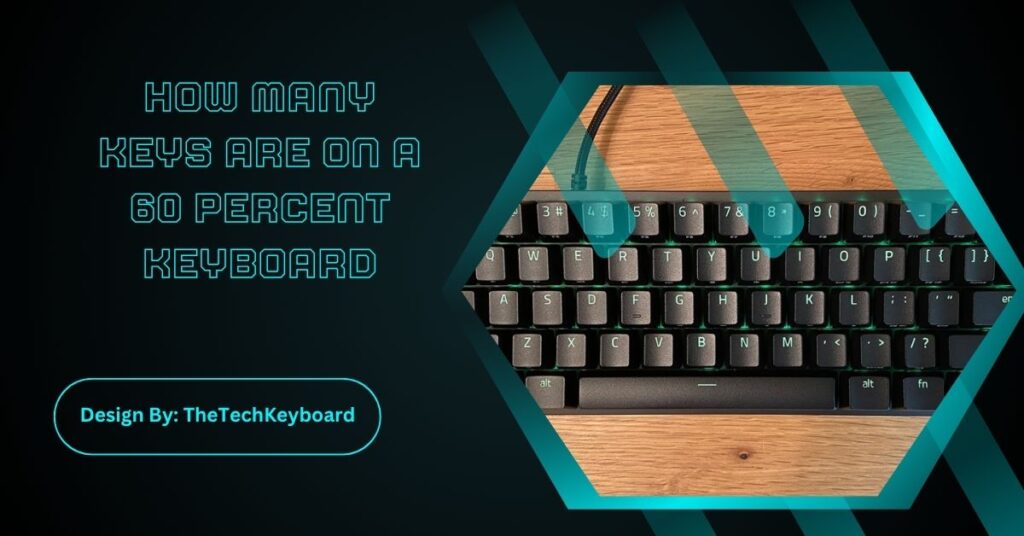A 60 percent keyboard typically has 61 to 62 keys, depending on the layout. It’s compact, portable, and uses a function layer to access missing keys like arrows and function rows.
If you’ve been exploring the world of keyboards, you might have come across something called a 60 percent keyboard. These keyboards are small, stylish, and perfect for people who want a clean desk setup. But the first question many people ask is: How many keys are on a 60 percent keyboard?
The answer is usually 61 keys, but there’s a lot more to know about this compact keyboard size. In this guide, we’ll talk about the 60 percent keyboard key count, its layout, size, advantages, and whether it’s the right choice for you.
What is a 60 Percent Keyboard?
A 60 percent keyboard is a small form factor keyboard that has about 60% of the keys found on a full-size keyboard. It removes extra keys like the number pad, arrow keys, and the function row (F1–F12) to make the design smaller.
This means a 60% mechanical keyboard size is perfect for people who:
- Want more desk space
- Like a clean and simple design
- Travel and need a portable keyboard
- Prefer a compact keyboard key layout for comfort
Even though the keyboard is smaller, it still has all the important keys for typing and gaming.
How Many Keys Are On a 60 Percent Keyboard?

The number of keys on the 60% keyboard is usually 61 keys in the ANSI layout (commonly used in the US). If you use the ISO layout (common in the UK and Europe), you might have 62 keys.
Here’s the breakdown:
- ANSI Layout (US) → 61 keys
- ISO Layout (UK/EU) → 62 keys
Some brands may make small changes, so the 60% keyboard switch count can be slightly different. In rare cases, special models may have extra programmable keys.
So if you’re wondering how many buttons on a 60 keyboard, the answer is generally 61–62 keys.
60 Keyboard Layout – What’s Missing?
A 60 keyboard layout keeps the main typing area but removes:
- Function row (F1–F12)
- Number pad
- Arrow keys
- Dedicated navigation keys (Home, End, Page Up, Page Down, Insert, Delete)
These missing keys are not gone completely—they are hidden in a second layer called the function layer.
What is the Function Layer?
Because a 60% keyboard missing keys might sound limiting, manufacturers use the 60% keyboard function layer to make sure you can still access all commands.
This works by holding a special key (often labeled Fn) along with another key. For example:
- Fn + 1 = F1
- Fn + P = Print Screen
- Fn + I/J/K/L = Arrow keys
- Fn + Backspace = Delete
This setup takes a little time to get used to, but once you learn it, you can use the keyboard just like a full-size model.
Size and Dimensions of a 60 Percent Keyboard
One reason people love these keyboards is their small size. The 60 percent keyboard dimensions are usually around:
- Width: 11.5 inches (29 cm)
- Depth: 4 inches (10 cm)
- Height: 1.5 inches (3.8 cm)
This makes it much easier to carry in a bag or place on a small desk. Compared to a full-size keyboard, the small form factor keyboard leaves a lot more room for your mouse and other accessories.
60% Gaming Keyboard Keys – Why Gamers Love Them?
If you’re into gaming, especially first-person shooters (FPS), a 60% gaming keyboard keys layout can be a game-changer.
Here’s why:
- More mouse space – Important for low sensitivity aim in games.
- Better hand position – Your arms stay closer, which can reduce strain.
- Faster reaction time – No extra keys to get in the way.
- Customization – Many mini mechanical keyboard layout designs allow you to program your own shortcuts and macros.
60% Keyboard vs Full Size Keys – The Differences!
Let’s compare the 60% keyboard vs full size keys to see the pros and cons:
| Feature | 60% Keyboard | Full-Size Keyboard |
| Key Count | 61–62 | 104–108 |
| Size | Compact | Large |
| Number Pad | No | Yes |
| Function Keys | Via Fn layer | Dedicated row |
| Portability | Easy to carry | Bulky |
| Desk Space Needed | Very little | A lot |
If you use the number pad often, a full-size might be better. But for gaming, travel, or small desks, the keys on compact mechanical keyboards make the 60% option more appealing.
Advantages of a 60 Percent Keyboard

- Portable and lightweight – Easy to carry anywhere
- Minimalist look – Clean and modern desk setup
- More space – Better mouse movement for gaming
- Customizable – Many allow custom key mapping
- Durable – Most are mechanical and built to last
Disadvantages of a 60 Percent Keyboard
- Learning curve – Must get used to using Fn layer for missing keys
- Not ideal for number-heavy work – No number pad
- May require remapping – Some keys might need customization for comfort
Who Should Use a 60 Percent Keyboard?
A 60 percent mechanical keyboard size is great for:
- Gamers who want more space for the mouse
- Writers and coders who want a portable setup
- Minimalists who like clean and small keyboards
- People with small desks or limited space
It may not be the best for accountants or data entry workers who need a number pad daily.
FAQs:
1. Why does a 60 percent keyboard have fewer keys?
It removes extra sections like the number pad, function row, and arrow keys to save space. These keys are accessed through the function (Fn) layer, keeping the keyboard compact but fully functional.
2. Is a 60 percent keyboard good for gaming?
Yes. Gamers love it for its small size, extra mouse space, and customizable key mapping. The layout supports fast reactions, especially in FPS games, while still providing essential controls via the Fn layer.
3. How do you use arrow keys on a 60% keyboard?
Arrow keys are accessed through the function layer, typically by holding the Fn key and pressing specific letter keys (often I, J, K, and L), depending on the keyboard’s programmed layout.
4. What is the size of a 60 percent keyboard?
A 60% keyboard usually measures around 11.5 inches wide and 4 inches deep. This makes it lightweight, portable, and perfect for travel or small desk setups while keeping a mechanical feel.
5. Who should avoid using a 60 percent keyboard?
Anyone who relies heavily on a number pad, dedicated arrow keys, or quick access to function keys may find it inconvenient. It’s less ideal for accountants, data entry jobs, or heavy spreadsheet work.
Conclusion
A 60 percent keyboard offers a compact, minimalist design with 61 to 62 keys, making it ideal for gamers, travelers, and small desk setups. While it removes dedicated function keys, arrows, and the number pad, the function layer ensures full usability. Its portability, space-saving benefits, and customization options make it a favorite among mechanical keyboard enthusiasts. Although not perfect for number-heavy tasks, its comfort, style, and efficiency make it a solid choice for those seeking a clean and functional typing experience.


